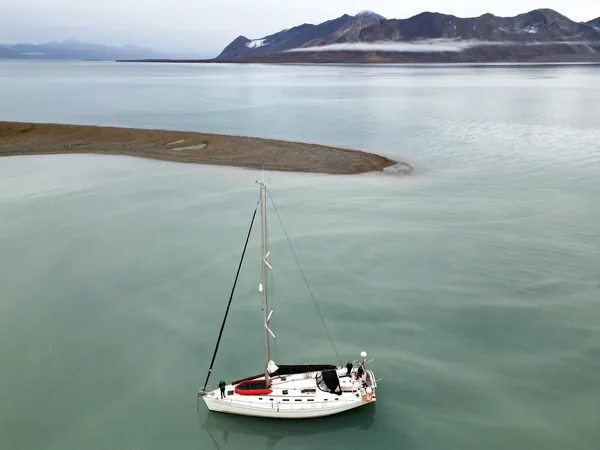
Surprising Findings: Arctic Sediment Insights Unveil Storm Patterns That Challenge Climate Change Assumptions
2024-11-11
Author: Wei
Introduction
Recent research led by Willem van der Bilt from the Department of Earth Science at the University of Bergen and the Bjerknes Center has uncovered astonishing findings about storm patterns in the Arctic, highlighting a complex relationship between climate conditions and weather phenomena. In collaboration with Mateusz Strzelecki from the University of Wrocław in Poland, their team has employed innovative methods to extract critical information regarding hazards from geological archives such as lake sediments.
Research Focus
In their groundbreaking study, published in *Nature Communications*, the researchers focused on coastal deposits in Svalbard—an area increasingly affected by climate change. Their findings center on storminess, analyzing wind- and wave-driven particles like sand and sea salt that accumulate in coastal lakes, revealing changes in wind strength and wave heights over millennia.
Significance of the Study
"The significance of this study lies in utilizing advanced scanning techniques typically reserved for deciphering other geological events, such as glacier behavior or flood frequency, to now explore wind patterns," explains van der Bilt.
This research arises against a backdrop of alarming environmental changes in the Arctic. With the rapid loss of sea ice, storms have become more consistent and destructive, leading to increased coastal erosion. This dynamic poses a dual threat: devastated infrastructure and the alarming release of vast carbon reserves stored in thawing permafrost—a major contributor to climate change.
Sediment Analysis and Findings
The researchers dug into the sediments of a coastal lake in Svalbard, preserving their historical wind signals, following a deliberate methodology that enhanced traditional geostatistical techniques. What they discovered, however, was an unexpected twist in climate narratives.
While many anticipated a correlation between a warming Arctic and increased storm activity, the sediment analysis revealed the opposite: stormy phases coincided with colder climate conditions in the North Atlantic. "Our results defy conventional wisdom; a warming Arctic does not necessarily equate to more winds," states van der Bilt. This contrasts deeply with prevailing assumptions about climate change and suggests that the understanding of historical climate behavior may be far more intricate than previously considered.
Storminess Cycle
The study further discovered a 1,500-year cycle of storminess within the region, resembling a heartbeat of climatic changes that occur in sync with the two primary wind systems—the Polar Easterlies and Westerlies. This linked behavior highlights a deeper interconnectedness in atmospheric processes, potentially driving further research into the complexities of wind patterns in relation to climate conditions.
Implications of the Research
Ph.D. student Zofia Stachowska, who served as the first author of this significant study, expressed enthusiasm about the research's implications. "This study not only fills crucial knowledge gaps but also challenges preconceived notions about climate change's impact on storms. The correlation between cold periods and increased storm activity is particularly intriguing," she highlights.
Stachowska, who employed advanced techniques like high-resolution scanning to reveal intricate details in sediment records, has high hopes for the implications of their research. "Our findings are not merely academic; they resonate with real-world concerns about coastal stability and carbon release in the face of climate change," she asserts.
Future Research and Conclusions
With Svalbard warming at rates significantly above the global average, understanding these trends is crucial. The research team believes their work could pave the way for future studies in the emergent field of paleotempestology—the examination of past wind changes—and ultimately contribute to more effective climate models.
Supervisors van der Bilt and Strzelecki echo this sentiment, expressing excitement over the study’s potential impact. "This area warrants further exploration; there is so much more to discover about our climate's historical and future dynamics," they affirm.
As the Arctic continues to act as a barometer for global climate change, these findings serve as a stark reminder that our understanding of weather patterns is still evolving and that the narratives surrounding our planet's future may need reevaluation.



 Brasil (PT)
Brasil (PT)
 Canada (EN)
Canada (EN)
 Chile (ES)
Chile (ES)
 España (ES)
España (ES)
 France (FR)
France (FR)
 Hong Kong (EN)
Hong Kong (EN)
 Italia (IT)
Italia (IT)
 日本 (JA)
日本 (JA)
 Magyarország (HU)
Magyarország (HU)
 Norge (NO)
Norge (NO)
 Polska (PL)
Polska (PL)
 Schweiz (DE)
Schweiz (DE)
 Singapore (EN)
Singapore (EN)
 Sverige (SV)
Sverige (SV)
 Suomi (FI)
Suomi (FI)
 Türkiye (TR)
Türkiye (TR)